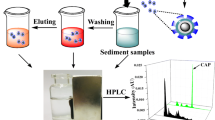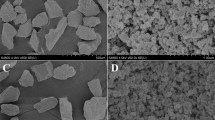Abstract
The synthesis and evaluation of a molecularly imprinted polymer (MIP) as a selective matrix solid-phase dispersion (MSPD) sorbent, coupled with high-performance liquid chromatography for the efficient determination of chloramphenicol (CAP) in fish tissues are studied. The polymer was prepared using CAP as the template molecule, vinylpyridine as the functional monomer and ethylene glycol dimethacrylate as the cross-linking monomer, and sodium dodecyl sulfate as the surfactant in the presence of water as a solvent by miniemulsion polymerization. The CAP-imprinted polymers and nonimprinted polymers (NIPs) were characterized by Fourier transform IR spectroscopy, scanning electron microscopy, and static adsorption experiments. The CAP-imprinted material prepared showed high adsorption capacity, significant selectivity, and good site accessibility. The maximum static adsorption capacity of the CAP-imprinted and the NIP material for CAP was 78.4 and 59.9 mg g-1, respectively. The relative selectivity factors of this CAP-imprinted material were larger than 1.9. Several parameters influencing the MSPD process were optimized. Finally, the CAP-imprinted polymers were used as the sorbent in MSPD to determine CAP in three kinds of fishes and resulted in satisfactory recovery in the range 89.8–101.43%. CAP-imprinted polymer as a sorbent in MSPD is better than C18 and attapulgite in terms of both recovery and percent relative standard deviation. The baseline noise was measured from a chromatogram of a blank fish sample which was treated after the MSPD procedure using CAP-imprinted polymer as a sorbent. Signal values of 3 times the noise (signal-to-noise ratio of 3) and 10 times the noise (signal-to-noise ratio of 10) were used to calculate the limit of detection and the limit of quantitation of the calibration curve. The limit of detection for CAP was 1.2 ng g-1 and the limit of quantitation was 3.9 ng g-1.





Similar content being viewed by others
References
Wulff G, Sarhan A (1972) Angew Chem Int Ed Engl 11:341–346
Vlatakis G, Andersson LI, Muller R, Mosbach K (1993) Nature 361:645–647
Watabe Y, Hosoya K, Tanaka N, Kubo T, Kondo T, Morita M (2005) J Chromatogr A 1073:363–370
Lakshmi D, Prasad BB, Sharma PS (2006) Talanta 70:272–280
Nie F, Lu J, He Y, Du JX (2005) Talanta 66:728–733
Yang GL, Liu HY, Wang MM, Liu SB, Chen Y (2006) React Funct Polym 66:579–583
Jiang XM, Tian W, Zhao CD, Zhang HX, Liu MC (2007) Talanta 72:119–125
Ugelstad J, El-Aasser MS, Vanderhoff JW (1973) Polym Lett Ed 11:503–508
Dawkins JV (1989) In: Allen G, Bevington JC (eds) Comprehensive polymer science. Pergamon, Oxford, pp 231–251
Ye L, Weiss R, Mosbach K (2000) Macromolecules 33:8239–8245
Perez N, Whitcombe MJJ (2000) J Appl Polym Sci 77:1851–1859
Priego-Capote F, Ye L, Shakil S, Shamsi AS, Nilsson S (2008) Anal Chem 80:2881–2887
Vaihinger D, Landfester K, Krauter I, Brunner H, Gunter EMT (2002) Macromol Chem Phys 203:1965–1973
Garcia-Lopez M, Canosa P, Rodriguez I (2008) Anal Bioanal Chem 391:963–974
Crescenzi C, Bayoudh S, Cormack PAG, Klein T, Ensing K (2001) Anal Chem 73:2171–2177
Kubala-Drincic H, Bazulic D, Sapunar-Postruznik J, Grubelic M, Stuhne G (2003) J Agric Food Chem 51:871–875
Xiao HB, Krucker M, Albert K, Liang XM (2004) J Chromatogr A 1032:117–124
Zhao M, Van der Wielen F, De Voogt P (1999) J Chromatogr A 873:129–138
Pensado L, Casais MC, Mejuto MC, Cela R (2005) J Chromatogr A 1077:103–109
Tolls J, Haller M, Sijm DT (1999) Anal Chem 71:5242–5247
Ahmed AF, Ahmad J, Amer AR, Saif AH (2007) Environ Geol 51:1317–1327
Dai RL, Zhang GY, Gu XZ, Wang MK (2008) Environ Geochem Health. doi:10.1007/s10653–007–9130–0
Keito B, Naomitsu S, Kazuo M (2001) J Am Oil Chem Soc 78(7):733–736
Yan HY, Qiao FX, Row KH (2007) Anal Chem 79:8242–8248
Vivekanandan K, Swanmy MG, Prasad S, Mukherjee R (2005) Rapid Commun Mass Spectrom 19:3025–3030
Bogusz MJ, Hassan H, Al-Enzai E, Ibrahim Z, Al-Tufail M (2004) J Chromatogr B 807:343–356
European Council (1994) Council Regulation (EEC) no. 2377/90 laying down a Community procedure for the establishment of maximum residue limits of veterinary medicinal products in foodstuffs of animal origin, amending regulation no. 1430/94 of 22 June 1994. Off J Eur Community L15623:6
Delahaut P, Levaux C, Eloy P, Dubois M (2003) Anal Chim Acta 483:335–340
Singer CJ, Katz SE (1985) J Assoc Off Anal Chem 68:1037–1041
Ferguson J, Baxter A, Young P, Kennedy G, Elliott C, Weigel S, Gatermann R, Ashwin H, Stead S, Sharman M (2005) Anal Chim Acta 529:109–113
Posyniak A, Zmudzki J, Niedzielska J (2003) Anal Chim Acta 483:307–311
Mottier P, Parisod V, Gremaud E, Guy P, Stadler R (2003) J Chromatogr A 994:75–84
Han DM, Fang GZ, Yan XP (2005) J Chromatogr A 1100:131–136
Raphael L, Scott M, Sergey AP, Soo-Hwan C, Kazuyoshi Y, Isao K (1997) Anal Chem 69:2017–2021
Mena ML, Agui L, Martinez-Ruiz P, Yanez-Sedeno P, Reviejo AJ, Pingarron JM (2003) Anal Bioanal Chem 376:18–25
Acknowledgements
This work was supported by the National Natural Science Foundation of China Fund (no. 20775029), the Huo Ying Dong Science Fund of China (no. 104038), the Program for New Century Excellent Talents in University (NCET-07–0400), and the Central Teacher Plan of Lanzhou University.
Author information
Authors and Affiliations
Corresponding author
Rights and permissions
About this article
Cite this article
Guo, L., Guan, M., Zhao, C. et al. Molecularly imprinted matrix solid-phase dispersion for extraction of chloramphenicol in fish tissues coupled with high-performance liquid chromatography determination. Anal Bioanal Chem 392, 1431–1438 (2008). https://doi.org/10.1007/s00216-008-2454-5
Received:
Revised:
Accepted:
Published:
Issue Date:
DOI: https://doi.org/10.1007/s00216-008-2454-5




